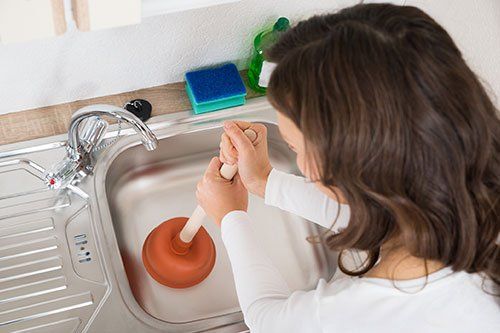Most toilet and drain clogs can be cleared with the use of a plunger. However, you need to use the plunger correctly in order to get results. If you have been plunging away, but to no avail, your lack of results may be due to improper plunging technique. The following are some of the most common mistakes homeowners make when attempting to plunge a drain.
Using the Wrong Plunger
Most families only own one plunger. However, you should really have at least two: one for the toilet and one for sink and shower drains. This is not just to avoid contaminating your sink with toilet germs. Sink plungers have a different shape than toilet plungers. If you try plunging a toilet with a sink plunger, you won't get good results.
For sink and shower drains, use a plain, bowl-shaped plunger with a flat, rubber head that looks like a suction cup. For toilets, use a flange plunger, the style that has a soft rubber flap emerging from its head.
Skipping the Petroleum Jelly
Before you start plunging, use your finger to apply a thin layer of petroleum jelly around the rim of the plunger. This will help keep the plunger in place as you work, and also ensures that it forms an airtight barrier even if the area around the drain is not completely flat. If you do not have plain petroleum jelly, vegetable shortening, or even coconut oil will work in a pinch.
Failing to Completely Submerge the Plunger Head
Many homeowners realize the drain is not draining, and then just insert the plunger head and start plunging away. But if there is not enough water in the sink or toilet to completely submerge the plunger head, your efforts won't be very effective. Forcing air - or a combination of air and water - down the drain does not do as much as forcing plain water down the drain.
Fill the sink or toilet with enough water to completely submerge the plunger head before you start working. If the water drains down as you work, you will need to stop and add more water to the sink periodically.
Holding the Plunger at an Angle
Especially as you really get into plunging and start applying force, you may unintentionally start holding the plunger at an angle. This breaks the seal between the plunger head and the drain. Focus on holding the plunger with the handle straight up and down as you work. It helps if you hold the handle a little further up and really lean your body over the drain as you plunge.
Failing to Maintain the Seal
In addition to holding the plunger at an angle, there are a few other mistakes that may cause you to break the seal as you plunge.
Many homeowners break the seal when they grow fatigued from plunging. To avoid this problem, start off with a gentle plunges, and then slowly increase the force. Plunge for only 20 seconds at a time, and then pull the plunger away. If the drain is still clogged, take a break to regain your stamina, and plunge again for 20 seconds.
You may also break the seal if you pull back too far as you plunge. You only need to move your hands a few inches to force water in and out of the drain without lifting the plunger head off the drain. Focus on making small, controlled movements.
If you are confident you're not making any of the mistakes above but your clog still won't clear with plunging,
contact Daytona Plumbing
to schedule an appointment. Some clogs, especially those located further down in the drain line, do need to be removed by a professional.







